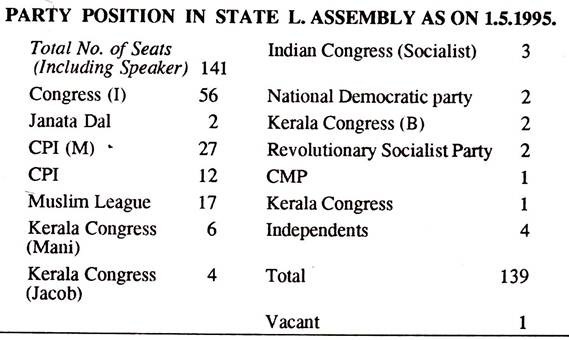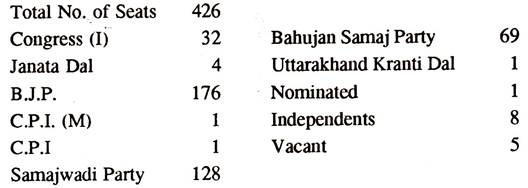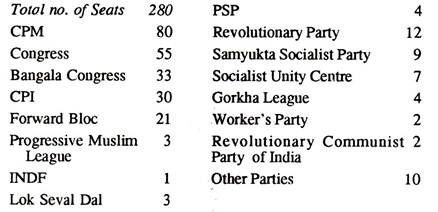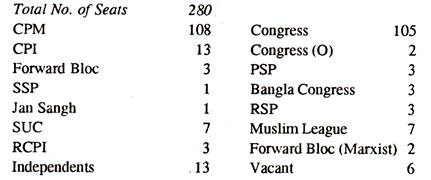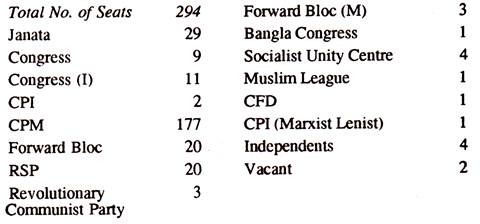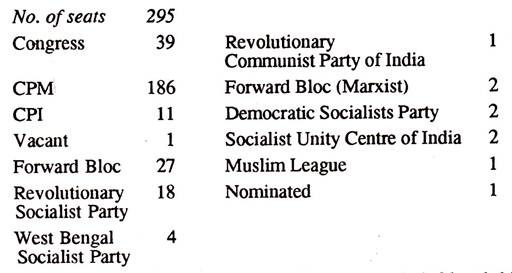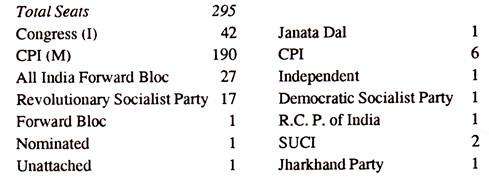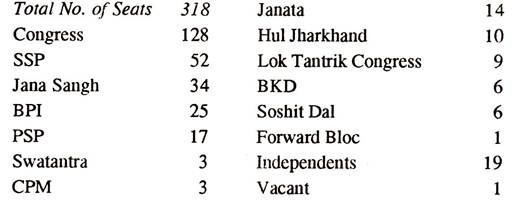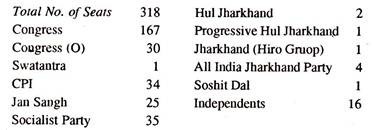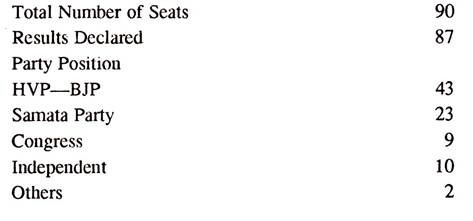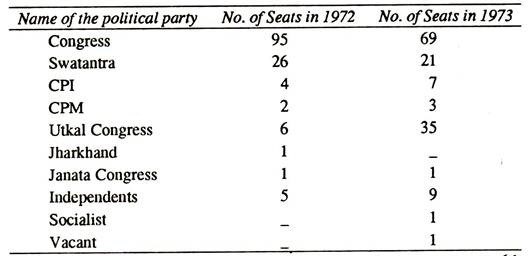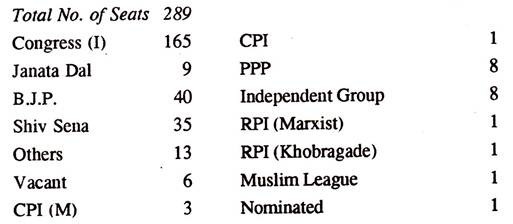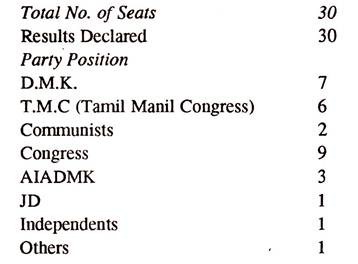In this essay we will discuss about the coalition politics in India. After reading this essay you will learn about: 1. Introduction to Coalition Politics in India 2. Back Ground of Coalition Politics in India 3. Meaning of Coalition 4. Coalition Politics in the Centre 5. Coalition Politics in the State.
Essay Contents:
- Essay on the Introduction to Coalition Politics in India
- Essay on the Back Ground of Coalition Politics in India
- Essay on the Meaning of Coalition
- Essay on the Coalition Politics in the Centre
- Essay on Coalition Politics in the State
1. Essay on the Introduction to Coalition Politics in India:
After the disappearance of Muslim League from the political scene of India in 1947, Indian National Congress was the only national party which commanded popularity and respect of the people. This party undoubtedly had mass base and worked at the grassroots in India.
Therefore, the power was ultimately transferred to this party, when British left India. The party had in its fold galaxy of all national leaders of those days. It was liberal in its approach to every national problem and flexible enough to absorb very divergent views.
It remained in power both at the centre as well as in the states right from 1947 to 1967, when its hold weakened due to several reasons. Important among these being death of Nehruji, India’s defeat at the hands of China and inflationary trends in Indian economy.
Since Indian National Congress was the only important political party on Indian scene, therefore, it had monolithic character. It was in power both at the centre and m the slates.
2. Essay on the Back Ground of Coalition Politics in India:
Fourth general elections in India were held in 1967 when its monolithic character somewhat weakened.
Before this election the hold of Congress party on political scene of India can be well imagined from the strength of various political parties in the Lok Sabha as on 15th April, 1966, which was as under:
Table on next page indicates support which each political party got from different states.
From these figures it becomes amply clear that leaving aside the States/Union Territories of J & K, Kerala, Nagaland and Goa, Daman and Diu, Congress party was in comfortable majority in all the States/Union Territories and as such the question of forming coalition government did not at all arise.
In J & K where 69 seats went to other parties, out of these 66 went to National Conference, where this party also had absolute majority to form government without coalition partners. Kerala at that time was under President rule.
In Goa, Daman, Diu the position, however, was fluid because there Maharashtravadi Gomantak party held 14, United Goans 12 and Pondicherry People’s Front 4 seats. In Nagaland Nationalist Organisation held 32 seats and thus enjoyed comfortable majority.
3. Essay on the Meaning of Coalition:
It was only after 1967 elections that coalition experiment in India started. But, before discussing this, it will be interesting to study, as to what is coalition system. Broadly speaking, coalition means uniting and coming together into one body for a particular purpose, which in other words means pooling of resources for achieving a particular purpose.
It also means joint use of resources and an alliance for joint action of various groups or organisations into a single government of distinct parties. In the word of Ogg, “Coalition, as employed in political sense, commonly denotes a co-operative arrangement under which distinct political parties, or at all events members of such parties unite to form a government or Ministry.”
Coalitions obviously come into existence to have some gains and rewards of both material and psychical nature and for this partners must be two or more. These come together under the force of certain circumstances and part company as soon as those circumstances cease to exist.
In every coalition joining partners are supposed to give up their rigid stand and follow the principle of give and take. More elasticity in approach, more lasting shall be the coalition.
The parties joining coalition agree to a minimum programme, but before reaching that there is always some bargaining by each partner to have maximum advantage. That programme becomes goal for all political parties to achieve during their partnership period.
But it does not mean that once the parties form a coalition they completely merge their identity. All the parties continue to maintain their identity. As soon as any of the coalition partner finds it difficult to pull on well with other partner(s) that leaves the coalition. In the process another party which higher to was not a coalition partner might join that and thus lend support to the coalition.
It is also just possible that some political party or parties might face break up due to internal feuds and one of the break away groups might decide to join the coalition as partner and the other might keep off from it.
When all the parties which agree to work together for implementing a particular common programme, but do not merge themselves to form a new party, is called a coalition. But as soon as they decide to merge themselves to form a new party then that no longer remains a coalition.
This is what happened when Janata party was formed and again the same can be said about the formation of Lok Dal. In some cases a political party may not like to join the coalition but may support it from outside. In 1979, a section of Congress party extended its support to Choudhry Charan Singh government from outside. Similarly government of V.P. Singh in 1989 was extended support by B.J.P. from outside.
In 1995, B.J.P. extended support from outside to Ms Mayawati government in U.P. In that case it can be called as indirect coalition partner. It is, however, left to every political party to withdraw such a support at any time. Thus, coalition system is a continuing process in which political parties come and go and new ones join and also withdraw and so on.
A coalition can have members belonging to any profession or field of activity. Needless to say that in political field the parties and organisations, join efforts to share power and have the best possible advantages and make every effort to win political arena in the face of all odds.
Each party goes to the farthest end to avoid defeat and for the purpose it uses all means and methods. The main aim of coalition is to capture power immediately or in the near future.
A coalition can work both in a tactic or formal form. In the former sense it means the role of single party in power but working with the indirect support of other political parties, whereas in the latter case parties which decide to come together join openly and share power.
This is what happened in 1979, when Charan Singh formed care-taker government. Congress (I) then with Y.B. Chavan as leader of the parliamentary party in the Lok Sabha and AIADMK joined the coalition government, but Congress (I) with C.M. Stephen as leader of the party in the Lok Sabha, decided to give its support to the government from outside, but decided not to join the government headed by Charan Singh.
In 1989, when National Front formed government both BJP and leftist parties decided to extend support from outside and did not join the government. Coalition can also be formed for constructive as well as destructive purposes.
When a coalition is formed with the object of pulling down political party in power and also that of providing an alternative government, it can be called positive coalition.
But when parties join and come together, just with the object of pulling down the government already in power and not taking the burden of forming a new government, or providing no other better alternative, then such a coalition can be called negative coalition.
The coalition partners perhaps never think in terms of permanent friendship. All of them realise that it is only a short term arrangement to achieve a particular end and nothing beyond that. In politics it means capturing political power from the opponent and retaining that for a maximum period.
It is all temporary arrangement and a compromise with selfish motives. In it the conflicts do not end but are just kept aside for the time being but these come to surface as soon as there are tension among coalition partners.
4. Essay on the Coalition Politics at the Centre:
Since independence Congress has been in power at the centre, except for a brief period of about 3 years in which Janata party came to power in February 1977 and care-taker government of Charan Singh, which took the reigns of government after the fall of Morarji Desai government in mid-1979 and for about a year in 1990 when National Front government under VP. Singh came to power.
All along Congress had been ruling the country both at the centre as well in the states till 1967, when as a result of elections the position of the Congress party considerably weakened, both at the centre as well as in in the states. It is evident from the position given on pages 137-138.
Thus whereas in 1962 Congress party had a comfortable majority with 375 members in the Lok Sabha, it came down to 284 in 1967 which was a serious set back to the party. The situation became still worse in 1969, when the party had a split and some Congress members of the Lok Sabha, who joined Congress (O) decided to withdraw their support from the group headed by Prime Minister, Mrs. Indira Gandhi, thus, reducing the government to a minority. For next two years there was tactic coalition at the centre, in which government survived only with the help of outside support of political parties like CPI and DMK.
The situation would have worsened had not the election results of 1971 brought one single party to power at the centre. But one healthy feature of a coalition was that the Congress party in power, on account of its broad outlook and flexible policies, did not make a mess of the system.
The party followed policy of appeasement towards other political parties, which were supporting it, and thus could win the co-operation of these parties.
When Presidential elections were held in 1969 late V. V. Giri was got elected, in spite of the opposition of Congress (O) which had the support of rightist parties like Jan Sangh and Swatantra. Even Congress (O) followed policy of appeasement and worked with rightist parties in the Parliament for quite some time.
But in 1971 elections to the l ok Sabha were again held and this time there was Indira Wave in the country. As a result Congress party, headed by Mrs. Gandhi came to power with two-thirds majority. It swept polls in the states as well and as such the question of forming coalition at the centre did not arise.
DMK, Muslim League and CPI continued to extend their support to the government from outside which was always a welcome for the party.
Party position in the Lok Sabha as on 5th April, 1971 was as follows:
Mrs. Gandhi’s government did not feel the necessity of forming any coalition government, her party having massive majority in the Lok Sabha.
In 1977 elections in the country were again held in which Congress party was defeated not only at the centre but in many states as well and Janata Party came to power. In this party five constituent political parties had merged themselves.
According to many Janata party was not a political party, but only a coalition of parties, in which five political parties having different political ideologies and view points had just merged themselves.
This was, first experiment of running a non-Congress government at the centre. The government at the centre had its own majority and that too quite comfortable, but still it welcomed Akali Dal and All India ADMK to join the government. Their representatives actually joined the Janata government.
Whether Janata party was one political party or not that theoretical question apart but in actual practice the party worked as a coalition. Its constituents did not pull on well with each other, each always feeling that the other was having better strong hold in the party as well as in the government. Each unit looked the other with suspicion and doubt.
This non-Congress experiment of running the government failed, in spite of fact that the party had a majority as will be seen from the Table given below:
State-wise position of these major political parties at that time was as under:
In 1979, Morarji government was forced to resign and there was again a non-Congress coalition at the centre. This time it was real coalition of Janata (S.) which was break away group of Janata party. Congress (U) joined the government as coalition partner. Congress (I) gave support to the government from outside.
The government did not face the Lok Sabha and as such it cannot be said whether it would have pulled on well or not. But even during this interim period crack came in the government. H.N. Bahuguna, who belonged to, break away CFD, a constituent of Janata party and who held finance portfolio left the government and so did several other Ministers of the lower ranks in the Council of Ministers.
The government could not get continued support of Congress (1). In this way non-Congress coalition experiment at the centre failed.
When nation went to polls in 1979 end, there was wide spread speculation that an era of coalition governments at the centre had ushered. It was hoped that no political party at the centre will get absolute majority. But that did not happen and Congress (I) was returned to power with massive two-thirds majority.
During these election Congress (I) contested maximum number of seats and polled the highest percentage of votes.
The position of votes polled by each political party was as under:
Being in such sound position in the Lok Sabha the Congress (I) party did not need the support of any other party for its survival. Elections were again held in the country at the end of 1984. This time too the Congress (I) had unprecedented win. The party won as many as 401 seats in a House of 545.
The position of each party in the Lok Sabha as on 24.5.1989 being as under:
Because of this strong position of the party in the Lok Sabha the question of any coalition did not arise. This brief account shows that whereas at the time of necessity Congress party could make the coalition survive, non-Congress coalition at the centre did not work well and bowed down under its own pressure. The party continued to maintain its strength as is evident from the statements on pages 145-146.
Election to the Lok Sabha were held in 1989. This time no political party won absolute majority to form the government. The ruling Congress (l) got only 193 seats, whereas newly formed National Front got 143 seats. Accordingly a sort of tatic coalition was formed at the centre.
National Front headed by V.P. Singh formed the government whereas BJP with 88 seats and left parties with 50 seats and some small groups extended their support from outside. Thus, in India at the Centre a minority government with majority support was installed. The experiment miserably failed when government fell after about a year.
In Rajya Sabha, the opposition continued have majority after 1980 as elections to this House are not held along with the Lok Sabha. One of the reasons as to why elections to the state Assemblies, in which Janata party lost in 1980 Lok Sabha elections was that the ruling Congress (I) wanted to capture as many seats in the Rajya Sabha as possibly it could. Thereafter, however, it continued to improve its position in that House as well.
The position of each party in the upper House as on 8.6.1989 being as shown on pages 147-148. It may be mentioned here that after the elections held in November 1989 for the Lok Sabha, the Congress(I) lost majority in that House but continued to have his hold in the Rajya Sabha (1989)
Election to the Lok Sabha were held in 1991 after the down fall of National Front government of V.P. Singh. This time congress party was returned to the Lok Sabha as single largest party but not with absolute majority.
Its leader formed the government with the outside support of some other parties and thus a tactic coalition was again formed. But as the time passed some members left their parties and joined ruling Congress (I).
In this way minority government became a majority government. Position of each party in the Lok Sabha as on 27.4.1995 was as under:
State wise position of parties in both the Houses of Parliament has already been given in the text else where.
Coalition after Eleventh Lok Sabha Elections:
Elections for constituting eleventh Lok Sabha were held in April-May 1996 as a result of which B.J.P. emerged as the single largest party and its leader Atal Bihari Vajpayee took oath as Prime Minister on 16th May, 1996. But he resigned as Prime Minister, as he had no hope of winning the vote of confidence of the Lok Sabha.
In the House there was no political party which could form the government on its own. Second largest party namely Congress (I) had only 135 seats and was not prepared to stake its claim for the formation of the government.
The only way out was the coalition government. Several parties then combined together and formed a United Front. Parties which joined the Front included C.P.I, C.P.M., F.B; R.SP; S.P; J.D; T.D.P. (Naidu); D.M.K; T.M.C; A.G.P; Indra Congress (T) and elected . H.D. Dev Gowda as their leader.
The Front has formed the government, with outside support of congress (I) and some left parties and thus for the first time coalition experiment has started at the centre.
5. Essay on Coalition Politics in the States:
As long as monolithic character of the party continued and Congress party remained in power, both at the centre as well as in the states, there was no question of any coalition government. But experiment in coalitions started really after the 1967 elections, when Congress lost heavily in some of the states and opposition parties came to power.
It was after this year that in several Indian states ‘Aya Ram and Gaya Ram’ process started. Party position in each state as on 1.4.1968 was as shown on pages 149-150.
From the foregoing it will be seen that Congress party was in majority in Andhra Pradesh, Assam, Gujarat, Haryana, J and K, Mysore, Maharashtra and M.P., whereas it was in minority in Bihar, Kerala, Orissa, Punjab, Rajasthan, U.P. and West Bengal.
It is an interesting study to be undertaken as to how each of the stale where Congress could not form a government and Non-Congress parties formed a government functioned and under what circumstances did these break out.
Kerala:
In Kerala, a United Front coalition consisting of CPM, CPI, SSP, RSP, KTP and KPS formed government on 5th March, 1967, with E.M.S. Namboodripad, as Chief Minister. But soon the coalition came under strains because coalition partners charged the Chief Minister of protecting his own party people.
There was also no improvement in food, as well as law and order situation. CPM also organised Gopal Sena which murdered those who worked for the landlords and began searches of foodgrains hoarders, etc.
In turn Congress and Kerala Congress founded Citizen’s Council. In November, 1967 activities of CPM workers became more violent in some areas of the state under the leadership of Narayana and his daughter Ajitha.
Some of the constituents units demanded that judicial enquiries should be held against the Marxists, who were attacking even police stations. The constituents of UF government also began to charge each other of corruption and bribery.
The Chief Minister ordered an enquiry into corruption charges against CPI and ISP Ministers but refused to order enquiry against Marxist Ministers, five MLAs of die parties against whom enquiries were ordered resigned on 17th October, 1969.
On October 24, 1967 House passed a resolution by which it resolved that corruption charges against all other Ministers should also be investigated. As a protest the Chief Minister resigned.
On November 1, 1966, a new coalition Ministry headed by C. Achuta Menon (CPI) was formed with the support of Congress. The coalition partners now were CPI, ISP, RSP and Kerala Congress. This was intolerable for CPM, and the party started violent activities in the state. The workers began to forcibly capture private land and adopted obstructionist activities inside the Assembly.
They did not allow the Governor to read his Address. It was also propagated that the new government was not interested in implementing land reform policies. But the government survived all these shocks and it became clear that it enjoyed comfortable majority, when a vote of thanks to the Governor, for his Address to the House was passed by 73 to 55 votes.
This still more baffled the CPM and the party followed obstructionist policies in the Assembly. They did not allow the government to function and the House was dissolved on 26th June, 1970 and the state was put under President’s rule on 4th August, 1970. Thus, ended first experiment of coalition governments in the state.
In September 1970 elections were again held in the state. This time one Front was dominated by CPM, the other by CPI, and still other by Congress (O). CPM front had its allies SSP, KSP and KIP, whereas CPI had among its supporters RSP, PSP and Muslim League. Congress (O) had its allies in Kerala Congress, Jan Sangh, Swatantra Party, DMK and ISP.
As a result of elections Congress party won 32, CPM 26, SSP 6, KIP 2, KSP 2, CPI 16, Muslim League 11, RSP 6, PSP 3, Kerala Congress 12, ISP 3 and independents 12. CPM was definite loser as its strength in the Assembly which was 52 in 1967 came down to 37 in 1970, whereas that of Kerala Congress improved and its strength increased from 5 to 13. Congress party emerged as the single largest party in the Assembly.
In the new Assembly one important reason for the downfall of the CPM was popularity of Prime Minister Smt. Indira Gandhi and her appeal to young voters to vote for her party. In October 1970, Achuta Menon formed coalition government with the support of the Congress from outside. Normal term of the Assembly was to expire in July 1975, but that was extended by another 6 months.
In 1977, elections were held for the state assembly and Kerala again carried on coalition experiment.
Party position in the state Assembly on 1.3.1978 was as under:
This time the Ministry was headed by K .Karunakaran but it survived only for 3 months. In April 1977 he was succeeded by A. K. Anthony as State Chief Minister. In 1980 elections CPM captured two-thirds majority in the Assembly and a new Ministry headed by E. K. Nayanar was formed in January of that year.
The Ministry remained in office for about 2 years which was made to resign. New government was headed by K. Karunakaran but there were internal conflicts and it resigned. Due to political instability in the State President’s rule was imposed.
In May 1982 elections for the state Assembly were again held and this time United Democratic Front headed by Congress (I) was returned to power. It captured 77 seats as against 63 captured by Left Democratic Front led by CPM. Accordingly a United Democratic Front formed government with K. Karunakaran as its Chief Minister.
In 1987 elections were again held for State Assembly. Left Democratic Front led by CPI won 76 seats in the House of 138 and thus threw United Democratic Front out of power.
Election for the Kerala Assembly were again held in 1991 in which Congress(I) led United Democratic Front captured majority of the seats in a House of 140 whereas Left Democratic Front got the second position. UDF formed the government under the leadership of K. Karunakaran.
But after some time some parties in the government demanded change in state leadership and threatened that in case their demand was not accepted they would leave the front. Accordingly in Mid 1995 K. Karunakaran resigned as State Chief Minister and was replaced by A.K. Anthony. The former joined the Central government as Cabinet Minister.
Party position in the State Assembly as on 1.5.1995 was as under:
Elections for the State-Assembly were held in April-May, 1996 as on result of which no single party emerged which could form government on its own. 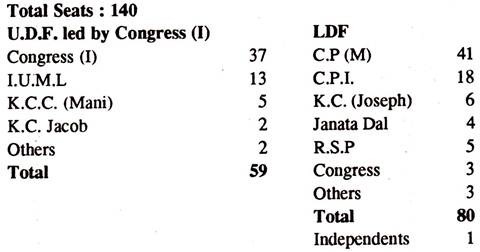
Thus the state had to work under coalition system, as in the past. Whereas before these elections U.D.F. was in majority, now L.D.F has come to power.
In the state there is hold of the leftist parties, who among themselves form Fronts and join together. Janata Party which swept the polls in North India, did not fair well in the state. Congress (I) is playing a significant role in state politics. The state so far has not attained political stability.
Uttar Pradesh:
U.P. is one of such states, which was traditionally considered a strong hold of the Congress party. It was this state which so far has given several Prime Ministers to the country. In the central cabinet U.P. always got and continues to get very good representation and moulds national politics.
In 1967 elections out of 425 seats of Legislative Assembly Congress party got only 195 seats and no political party got absolute majority, and coalition governments had to be formed.
The opposition parties joined together to form United Front Government and elected Ram Chandra Vikal as their leader. But an old Congress stalwart C.B. Gupta could form government in the state. But on the allocation of portfolios, Chief Minister developed differences with Charan Singh, another prominent state leader.
There were elections and C.B. Gupta government suffered a defeat on 1st April, on the motion of vote of thanks to the Governor for his address. Chief Minister then resigned. United Front now elected Charan Singh as its leader, who took over as State Chief Minister on 3rd April, 1967.
But after few months differences in the SVD (Samyukta Vidhayah Dal) came on the surface. In June 1967 some Swatantra ML As and a Minister of that party resigned from the government. On October 6, the party declared withdrawal of support from the government. On October 15 of the same year seven SSP and CPI Ministers resigned on the issue of release of political prisoners arrested in connection with 1966 agitation.
On 5th January, 1968 three SSP Ministers decided to leave and Jan Sangh, a constituent of the government and party badly criticised the Chief Minister. Since criticism from all corners was mounting Charan Singh tendered his resignation to the Governor on 17th February 1968 and thus ended the experiment of coalition government.
On 25th February, 1968 state was placed under President rule and Assembly was kept in a state of suspension. It was dissolved on 15th April, 1968.
Fresh elections to the state Assembly were held on February 9, 1969 and this time Congress improved its position. It won 211 seats, as against 195 captured by it in 1967. BKD of Charan Singh captured 99 seats but Jan Sangh suffered a set back when it captured 49 seats only as against 98 in 1967.
Similarly SSP which had 44 seats in 1967 had to satisfy itself with only 33 now. Swatantra party lost 7 seats and now had 5 only. As compared with 14 seats in 1967, now CPI had 4 and PSP 3 as compared with 11 in 1967. Republican party still more suffered. It had 9 seats in 1967, but got only 1 now and conditions of independents was in no way better, as against 37 seats in 1967 they now had 18 only.
Though Congress party had no absolute majority yet with the help of few independents party leader C.B.Gupta could form Congress government on 25th February, 1969. But in 1969 there was split in the party resulting in instability. Kamlapati Tripathi and his supporters who sided with the Prime Minister, decided not to support C.B. Gupta government, as the Chief Minister was with Congress (0).
They started negotiations with B.K.D. leader Charan Singh, for the formation of a coalition government. Meanwhile in order to save his position C.B. Gupta also started negotiations with Charan Singh. On 10th February, 1970 C.B. Gupta tendered his resignation as Chief Minister and suggested the Governor to invite Charan Singh to form government.
He assured his support and support of SSP and Jan Sangh to him. But soon after differences between BKD and other parties developed and Charan Singh decided to form government with co-operation of Congress (N). He was sworn-in as Chief Minister on February 17, 1970.
But it did not take long when differences between BKD and Congress (N) developed on taking over of private mills and abolition of compulsory membership of students unions on the one hand and merger of Congress and BKD on the other. These widened when BKD group in Parliament voted against abolition of Privy Purses.
Finding that Tripathi group might withdraw its support from the government Chief Minister negotiated with Congress (O), Jan Sangh and Swatantra parties.
On 24tli September Charan Singh asked for the resignation of the Congress Ministers and immediately Congress decided to withdraw its support from the government. Tripathi wrote to Governor that since Chief Minister was leader of only a minority in the Assembly, therefore, his advice about dissolution of Assembly may not be accepted. Congress (O), Jan Sangh, SSP and Swatantra parties immediately intimated the Governor that they had decided to extend their support to the Chief Minister. Since Governor was in a fix he called for the advice of Attorney General Niren De and State Advocate General K.L. Mishra.
The opinion of the two about the dismissal of Chief Minister differed and Governor acting on the advice of De recommended to the President to place State under President rule. A special courier was sent to Russia, on October 1, 1970, where President was away on tour and after getting his approval state was placed under President rule on October 2, 1970.
The action of the President was much criticised by opposition parties, both in the Parliament and outside.
Few days later, BKD, Jan Sangh, Swatantra and SSP formed SVD and elected T.N. Singh as their leader. Tripathi staked his claim to form the government but Singh was invited to form new government. He was sworn in as Chief Minister on October 17, 1970.
Since T. N. Singh was not a member of the Assembly he contested by-election on January 5, 1971 but was defeated and offered to resign. He was, however, asked to continue till March 1971, when Lok Sabha elections were due. As a result of these elections Congress won 73 out of 85 Lok Sabha seats.
This influenced state politics and many SVD members left the party and joined Congress reducing it to minority position, T. N. Singh government was defeated in the Assembly on 30th March, 1971. Tripathi took over as new Chief Minister of the state on 14th April, 1971.
Tripathi government, however, faced serious crisis in summer 1973 due to student agitation and in order to improve the image of the party Chief Minister recommended the Governor to bring the state under President rule and this was done on 12th June, 1973. This action of the Governor was much criticised by opposition parties. President rule continued till 27th October.
The party by now felt that in order to be on an advantageous position it should again hold reign of office in the state and on 27th October Governor was requested to lift President rule from the state as situation had already much improved. On 6th November, 1973, H. N. Bahuguna was sworn in as U.P.’s new Chief Minister.
Between 24th to 26th February 1974 elections for U.P. state Assembly were held in which Congress came to power with absolute majority.
Party position being as follows:
H. N. Bahuguna was elected leader of the Congress party and he was sworn in as state Chief Minister on 5th March, 1974. Since party was in absolute majority there was no coalition experiment.
In 1977, Janata Party came to power at the centre and it decided that since Congress party had lost contacts with the people, therefore, fresh elections should be held in the state. As a result of these elections, Janata party came to power with absolute majority in the State Assembly.
Party position in the state on 3-9-1978 being as follows:
Since Janata party was in absolute majority, therefore, there was no question of formation of a coalition government.
In 1980 Congress (I) came to power at the centre and decided that election to the state Assembly should be held afresh, as the Janata Party had lost contacts with the people. As a result of these elections Congress (I) was returned to power with absolute majority.
Therefore, there was no question of formation of coalition government with any other political party in the state and Congress formed the government by itself. In a House of 425, it had a strength of 306.
In March 1985 elections were again held for the state Assembly. This time Congress (I) won 266 seats. Again there was no need for the formation of coalition government in the state.
Party position in the state Assembly as on 6.4.1989 was as under:
In 1989 elections to UP Legislative Assembly were held in November of that year, along with the Lok Sabha elections. Ruling Congress (I) lost majority and National Front came to power, without any need for a coalition government.
The party position then being as under:
Janata Dal and B.J.P. formed government in the State. The combine however could not do well and mid term polls in the state were held in May-June 1991. This time B.J.P. got clear mandate of the people.
The party position in the State Legislative Assembly beings as under:
The party formed government in the state under the Chief Ministership of Kalyan Singh. The government was working well when on December 6, 1992 Babri Masjid was demolished by some Kar Sewaks and the Chief Minister took responsibility on himself and tendered the resignation of his government. It was not a coalition government. After Chief Minister’s resignation the state was placed under President’s rule.
Election to the State Assembly were held again in November 1993 in which no party could secure absolute majority.
The party position being as under:
Coalition experiment once again began in the state. This time BSP and SP combined together and formed government under Mulayam Singh Yadav with the support of Congress (I) and some other parties. But Congress (I) state leadership insisted on the central leadership that party support from the government should be withdrawn.
The party position as on 1.4.1995 was as under:
There were, however, differences in the ruling SP and BSP and the latter decided to-withdraw support from the government. BJ.P legislature party there upon extended his outside support to B.S.P. for the formation of the government.
A new coalition type government was formed by B.S.P. leader Ms Mayawati but that lasted only for few months, when because of ideological differences B.J.P. withdraw its support from the government. The government then resigned and the Assembly was kept in suspension for few days and thereafter it was dissolved and the state was brought under President rule by October 1995.
Elections to the State Assembly were not held with the Lok Sabha elections in 1996.
Punjab:
Before 1st November 1966, Punjab was a composite state. Immediately after the formation of the state Giani Gurmukh Singh Musafir became state Chief Minister. In 1967, when elections were held in the state Chief Minister Musafir and some of his cabinet colleagues lost at the polls. No party had absolute majority in the Assembly. In a House of 104, Congress party emerged as the single largest group with 47 seats.
The opposition which could muster a combined strength of 53 elected Gurnam Singh as their leader and he was sworn in as state Chief Minister on March 8, 1967. But crisis developed when on 5th April, the government suffered a defeat on the vote of thanks to the Governor for his Address to the House and Congress party demanded government’s resignation.
The party tried to win over to its side some’ dissatisfied MLAs of the ruling alliance in a bid to form the Government. But its efforts were frustrated when in early May 5 Congress MLAs left the party and joined the ruling alliance. But meanwhile differences in the Akali Dal also developed and some of the members withdrew their support from the government reducing it to minority.
The Chief Minister resigned and recommended dissolution of state Assembly. Break away Akali MLAs formed united Punjab Janata party and elected Lachhaman Singh Gill as their leader. Congress decided to support him and on November 27, he was sworn in as state Chief Minister.
But this created differences in the Congress party itself. Some of the Congress MLAs favoured that the party should try to form its own government. Meanwhile Chief Minister wanted to remove Speaker J.S. Mann and instead get a senior Congress member Prabodh Chandra elected as Speaker of the House. On this Speaker Mann adjourned the House for 2 months.
This created an unprecedented situation because in the Assembly financial bill could not be passed before April 1. In order to deal with the situation Governor issued an ordinance and called for the session of the Assembly on March 18. Assembly session was all chaos. In 15 minutes in that chaos, finance bill was passed.
This was challenged by the opposition parties in the State High Court, which opined that passing of bill and convening of Assembly was ultravires. The government, however, filed an appeal against the decision of the High Court in Supreme Court and latter court ruled in favour of the government.
On 21st August, 1968 Congress party withdrew its support from Gill government and Chief Minister tendered his resignation. The Governor recommended introduction of President rule. The state was brought under President rule on 23rd August.
Mid-term polls in Punjab were held on February 9,1969 and Akali Dal emerged as the single largest group in the Assembly. The party elected Gurnam Singh as its leader and with the support of Jan Sangh, it formed government on 17th February. Some Congress and independent MLAs defected to the ruling party.
But in January 1970 differences within Akali Dal again developed and reached a point when Finance Minister Balwant Singh, who belonged to Sant group, refused to move Appropriation Bill in the Assembly. Akali MLAs removed Gurnam Singh from leadership and instead elected Parkash Singh Badal as their leader.
The former resigned on 20th March, 1970 and next day Badal was swom-in as state Chief Minister. In November 1970, there were again differences in Akali Dal and 16 MLAs withdrew their support from the government. This time differences were over the size of Ministry. Finding himself in minority Badal resigned on 13th June, 1971 and on 15th June state was brought under President rule.
In March 1972, elections were held in the state and Congress party came to power with absolute majority. Thus ended coalition politics drama in the state.
Party position in the state Assembly as on 1-7-1972 was as under:
As leader of Congress party Giani Zail Singh formed government in the state.
In 1977, elections were again held in the state and this time also there was no coalition experiment in the real sense of the term. As a result of elections Akali Dal was returned with absolute majority in the state Assembly. But the party decided to extend its support to Janata government at the centre.
Accordingly Parkash Singh Badal joined the central cabinet. When he was elected as leader of the state legislature party he resigned and his place was taken over by Surjeet Singh Barnala. Under this arrangement Janata party was made a coalition partner with Akali Dal in Punjab cabinet as well.
Party position as a result of 1977 elections in Punjab Legislative Assembly as on 3.9.1978 was as under:
Elections to the state Assembly were held in mid-1980. Again the necessity of coalition did not arise, because this time Congress (I) was returned to power with absolute majority and as leader of the majority party Darbara Singh formed government in the state. The party could secure 63 seats in a House of 117.
The party position then was as under:
But soon thereafter Akali agitation started in Punjab, which created law and order problem beyond the control of the state Government and in October 198 President rule was imposed.
Elections for the State Assembly were held in 1985 and as a result Akali Dal secured 73 seats in a House of 117 and their leader Surjeet Singh Barnala headed Akali Dal government on 29.9.1985. Soon after there were defections in the ruling party but with the support of Congress (1), B.J P., CPM and CPI it continued in office for some time. It, however, could not control deteriorating law and order situation and President rule was again imposed in the state on 11.5.1987.
Elections to the State Assembly were again held in February 1992 which were boycotted by several political parties. Voter’s turnout was only 22%. This time the need for forming coalition government did not arise because in a House of 117 congress (I) secured 87 seats, BSP 9; BJP 6 and CPI 4. Congress party formed government with Beant Singh as the Chief Minister.
He brought peace to the state but in August 1995 he became victim of militant’s bullets. He was succeeded by H.S. Brar as Chief Minister. The state is not faced with the problems of coalition government.
Party position in the state as on 1.4.1995 was as under:
West Bengal:
Bengal also saw an interesting drama of coalition politics. Ajay Kumar Mukerjee, one time Congress Party President, left the party and formed a new party with the help of left wing parties. In the elections which were held in 1967, though Congress emerged as the single largest party with 127 seats in a House of 280, yet all its efforts to form the government were frustrated when all opposition parties combined together were against it.
These elected Ajay Kumar Mukerjee as their leader, who was sworn-in as state Chief Minister in February, 1967. But soon differences developed in the government over the implementation of party programme. But on November 2, Dr. P.C. Ghosh an independent Minister resigned from the government, and intimated the Governor that 17 other members had also withdrawn their support from the government.
Subsequently 15 of them confirmed this. Congress party which had by then 130 members also informed the Governor that it would extend its support to Ghosh government.
The Governor then asked Chief Minister to convene a session of the Assembly at a very early date, but when he found that the latter was in no mood to do so, he dismissed Mukerjee government on 21st November and invited P. C. Ghosh to form the government. As a protest against the decision of the Governor there were violent demonstrations in the state.
Assembly session was called on 29th November and when the House met Speaker Bijoy Kumar Bannerjee adjourned the House sine die declaring that dismissal of Mukerjee government was unconstitutional and thereafter there were violent demonstrations in the state.
On 15th January, 1968 some MLAs who were so far supporting the government from outside, joined the government and announced the formation of Indian National Democratic Front (INDF), UF group decided to extend its support to INDF and their leader staked his claim to form government.
On 14th February Assembly met for its budget session but UF MLAs blockaded the doors when Governor came to deliver his address. He was made to enter from the back door, but could not read his Address. There were all chaos and finding that it was impossible to run the government Dr. Sen resigned and state was placed under President rule on 20th February, 1968.
Election to the state Assembly were held on 9th February, 1969. But after elections in the Assembly party position was such that no party was in
absolute majority and coalition experiment and politics had to be carried on.
The party position was:
In a House of 280, UF had voting strength of 156, but differences developed over the leadership of the party. Jyoti Basu staked his claim as leader of the party, being the leader of largest constituent unit. But this was not accepted by others. Ultimately after prolonged negotiations it was agreed that Ajoy Mukerjee shall be the Chief Minister, and Basu will join cabinet as Home Minister with police department.
On 25th February the new government came to power. But soon thereafter, CPM workers created law and order situation, looted properties of the people, instigated labourers to capture surplus land.
The situation became so worse that Chief Minister himself had to go on fast with thousand workers against high handedness of CPM workers. But Basu and Police Department did nothing to check the situation. The conditions so much worsened that at one point of time CPM students man-handled Chief Minister, but police present at that time did nothing to save the situation.
Finding that the situation was absolutely out of control, the Chief Minister tendered his resignation on 16th March and state was brought under President rule on 19th March, 1970. Finally, the Assembly was dissolved on 30th July and elections were held on March 10, 1971. Again no political party won absolute majority.
Party position being:
This again led to the problem of formation of government. After prolonged negotiations Congress decided to support Ajoy Mukerjee and on April 2, he formed his government. But after 2 months there were differences in Bangla Congress itself.
There would have been realignments but meantime Bangladesh crisis took place and Chief Minister recommended dissolution of the Assembly and this was done on 25th June and President rule was imposed on 28th June of the same year.
In 1972, elections to the state Assembly were again held but now there was no need for the formation coalition government because this time Congress party was returned with absolute majority.
The party position as on 1.7.1972 being as follows:
The Congress party continued to remain in power during emergency period as well. In 1977, when elections to the state Assembly were again held, this time Congress party was replaced by CPM. But again there was no need for the formation of a coalition government because CPM had absolute majority in the Assembly.
Party position in the Assembly on 1.9.1978 being:
In the State CPM government with Jyoti Basu as Chief Minister was formed and is still in office.
In 1980, non-Congress governments in 10 states/Union Territories were dissolved, but CPM led government in Bengal was not dissolved and continued to remain in position.
In March 1987 elections to the State Assembly were again held. This time CPI (M) led Left Front was again returned to power by capturing 242 seats in a House of 295. Jyoti Basu was again elected as leader of the majority party and sworn-in as Chief Minister.
Party position as on 1-4-1989 in the State Assembly was as under:
In 1991 elections to the State Assembly were again held and this time there was no need to form coalition government because CPI (M) by itself secured an absolute majority. In the House of 294 the party secured 187 seats and Congress(I) could secure only 43 seats. The party elected for the fourth time Jyoti Basu as its leader, who took over as Chief Minister and formed his government.
The party position in the state legislative Assembly as on 1.4.1995 was as under:
Elections for the State Assembly were held in April-May 1996 alongwith Lok Sabha elections. This time also Left Front headed by Jyoti Basu came to power. He formed government for the fifth time in a row. His party on its own had a majority. It won 150 seats, though in the earlier House it had 190 seats.
Bihar:
Bihar had its own experience of the working of the coalition system. In the state several coalition governments were formed, but each one was very short lived. There was always political instability in the state due to Ministry’s frequent coming and going out of power and dissolutions of state Assemblies.
In 1967 when elections were held for the state Legislative Assembly, Congress won 128 seats in a House of 318 but refused to form Ministry. There upon Mahamaya Parsad Singh formed government on March 5, with the support of non-Congress parties. But differences developed in the party and B.P. Mandal, a socialist member resigned from the government on 8th August and formed Soshit Dal.
He was supported by Congress and both of them defeated the government on 25th January 1968 in a vote of no confidence.
The Chief Minister resigned and B.P. Mandal formed new government on February 1, 1968. But new government had smooth sailing for few weeks only when cracks came in the Congress party and Bhola Paswan Shastri left that with 15 members. On March 18, 1968 Mandal government could not survive a vote of no-confidence moved by the United Front and Chief Minister resigned.
Thus, second time political instability came in the state.
Now with the help of United Front and some other small groups Bhola Paswan Shastri formed the government on March 22, 1968. But on May 1, as many as 20 MLAs resigned from BKD which was supporting the government, as their leader Raja of Ram Garh was not made Deputy Chief Minister.
Fearing that the Raja might cross the floor, the Chief Minister advised the Governor to dissolve the Assembly. He tendered his resignation and on 27th June Central Government took over state administration and the Assembly was dissolved on 29th June.
On 9th February, 1969 mid-term elections were held in the state and as a result Congress emerged as single largest group, winning 128 seats in a House of 318.
The party position after the election being:
Since no party enjoyed clear majority, therefore, there was no other alternative but to form coalition government. Hari Har Singh of the Congress party could get the support of some other parties and formed government on 27th February, 1969.
But soon thereafter differences arose among the coalition partners about distribution of portfolios and Soshit Dal and Hul Jharkhand, two constituents of the ruling party voted with the opposition on 20th June when vote on budget was taken. Hari Har Singh, therefore, resigned.
Next Chief Minister to be swom-in was Bhola Paswan Shastri, who took office of 22nd June. He got support from outside parties including SSP, PSP, CPI and Jan Sangh. But it did not take long for the differences to develop over the induction of two Muslim Ministers. Jana Sangh decided to withdraw its support from the Government.
Since there was political instability in the state, President rule was imposed in the state on 4th July 1969 and the Assembly was kept in suspense. In November 1969 Congress itself got divided and Congress (N) elected Daroga Mai Rai, as leader of the party in place of Hari Har Singh.
On 16th February, 1970 Governor invited Daroga Rai to form government in the state and President rule was lifted. But Daroga Rai government was also not free from its own troubles.
There were serious differences over the distribution of portfolios and internal troubles within the constituent units of the government, including Lok Tantrik Congress Group, PSP and BKD. Not only this, but within the Congress group there were differences and a campaign was launched in the party for the removal of Daroga Rai from party leadership.
On 18th December, opposition parties brought a vote of no- confidence against the government which was passed and Rai submitted resignation of his government.
On December 22, 1970 Governor invited SVD group leader Karpoori Thakur to form the government, but Thakur government too was not to last long and campaign against him was started by those who could not be accommodated in the government. Understanding the gravity of situation he tendered his resignation on 1st June, 1971.
On 2nd June 1971 Governor invited Leader of the Progressive Legislature Front Bhola Paswan Shastri to form the government. But he remained in office only up to 27th December 1971, when coalition partners quarrelled with each other and Shastri tendered his resignation. Since there was political instability in the state, on 29th December, 1971, President rule was imposed in the state.
In March 1972 General elections were held in the state. This time electorates voted Congress (N) to power.
Party position as on 1.7.1972 was follows:
Since Congress party was in absolute majority in the state, it elected Kedar Pandey as its leader and he took over as state Chief Minister. This ended coalition experiment, which had miserably failed in the state. But there were differences in the Congress itself over leadership issue and after remaining in office for few months, he was replaced by Abdul Ghafoor, as Chief Minister.
In the state Chief Ministers went on changing but there was no coalition government. In 1977 elections were again held in the state. This time voters voted in favour of newly formed Janata Party to power and as such there was no question of formation of coalition government again.
Party Position on 19, 1978 being:
In 1980 elections were again held in the state, when Congress (I) came to power at the centre. This time the people of the state voted Congress (I) to power and as such the question of coalition in the state did not arise.
Party position in the State Assembly being:
In March 1985 elections for the State Assembly were again held in which Congress won 192 seats. Being in absolute majority its leader Bindeshwari Dube was invited to form the government and he was sworn in as state Chief Minister. Thus ended coalition era in the state.
Party position in the State Assembly as on 8-7-1987 was as under:
The elections to the State Assembly were held in February, 1990 but this time no political party got absolute majority to form the government. Therefore, coalition type government headed by Laloo Prasad Yadav was formed, who was the leader of the largest single political party, namely, the Janata Party in the State Assembly. He could get the support of other parties also as well.
The party position after 1990 Assembly elections was as under:
In 1995 elections to the State Assembly were again held. This time the state was not faced with the problem of coalition experiment because JD headed by Laloo Prasad Yadav emerged as the largest party with absolute majority. He has formed his government in the State.
Party position in the state Legislative Assembly as on 1.7.1995 was as under:
Haryana:
The state of Haryana came into existence in November 1966 and Bhagwat Dayal Sharma was sworn-in as first Chief Minister of newly born state. Elections in the state were held in February, 1967 and in a House of 81, Congress got absolute majority by winning 48 seats and Sharma was again sworn-in as Chief Minister of the state, being the leader of the majority party.
But thereafter defection drama started and there were frequent floor crossings by MLAs resulting in political instability.
When the question of Ministry formation came, some Congress MLAs, who did not belong to his caste alleged that the Chief Minister was accommodating his own group people in the cabinet. 13 of them left the party and joined opposition parties and elected Rao Birender Singh as their leader.
As leader of the majority group Rao was invited to form government on 22nd March, when Devi Lai tendered his resignation. On March 24, Rao was sworn-in as Chief Minister.
But within few months differences in the ruling party developed over increasing influence of Jana Sangh inside the United Front Government. Some of this colleagues also charged Rao of corruption. Devi Lai, leader of the Congress group, claimed majority support but Governor maintained that Rao still had majority support.
The Chief Minister, in order to win the support of the legislators, started offering them ministerial berths. Meanwhile there were frequent floor crossings by MLAs and some of them crossed floor as many as five times. On November 17, Devi Lai decided to leave government and there was such an instability in die state Assembly that it had to be dissolved.
In May 1968 mid-term polls were held in the state and this time Congress got 48 seats and thus had absolute majority in the house. The party elected Bansi Lai as its leader and on 21st May, he was sworn-in as Chief Minister of the state. Opposition parties elected Rao Birender Singh as their leader. But defections again started.
But on 9th December, 15 Congress MLA, who were followers of Bhagwat Dayal Sharma left the ruling Congress and joined opposition. But few days later 7 of them again defected and joined ruling Congress. Since there was political instability in the state, on 21st January 1972, Assembly was dissolved.
In 1972 elections to the state Assembly were held and in a House of 81, Congress won 52 seats.
Party position in the Assembly on 1.7.1972 being as follows:
Due to absolute majority of Congress in the legislature, it formed a government on 14th March 1973, with Bansi Lai as Chief Minister. He proved to be a strong man and had the support of Prime Minister and her son late Sanjay Gandhi. He kept the party in tact.
But with the passage of time grudges against him also developed and he was removed from the scene and offered berth in the central cabinet. Even when he was drafted to the central cabinet, he maintained his control over state politics and did not leave an opportunity where by legislators could defect. Congress was in full authority, when elections were held in 1977.
In these elections, like many other states, here also Janata was returned to power with absolute majority.
On 1.9.1978 party position in the state Assembly being:
Since Janata Party was returned to power with absolute majority it formed government in the state without the co-operation of other parties. But Janata rule was known for its internal feuds and Chief Ministers changed, but there was no coalition even then. In mid-1979, when differences among the party constituents, became deep rooted. Bhajan Lai was elected state Chief Minister.
In 1980, when general elections for the Lok Sabha were held and Congress(I) was returned to power, he left Janata party and with his supporters presented himself to the Prime Minister. He and his supporters joined Congress (I) and was allowed to continue a Chief Minister.
Since the party had absolute major in the Assembly, therefore, there was no question of forming a coalition government. In middle of 1980, when elections to the state Assembly were held, Haryana did not go to polls.
In May 1982 Elections to the State Assembly were again held and this time no political party got clear majority. Congress (I) emerged as the single largest party with 36 seats and its leader Bhajan Lai was invited to form the government.
His government continued in position till July, 1987. Elections to the State Assembly were held on 17.6.87 and BJP and Lok Dal contested as combined. Lok Dal captured 58 seats and thus had absolute majority in the State Assembly. BJP got 15 seats in the House.
Lok Dal leader Devi Lai was swom-in as Chief Minister. He inducted some BJP leaders as Ministers in his cabinet. Technically there was a coalition government in Haryana.
Party position in the State Assembly as on 1.4.1989 was as under:
But subsequently rapid developments took place in the state when Devi Lai was elected as Deputy Prime Minister in National Front Government, his son Om Prakash Chautala took over as state Chief Minister. This was resented by B.J.P. which withdrew its representatives from the government and instead of coalition government, it now became Lok Dal (B) government.
But political instability in the state continued and ultimately in April 1991 State Assembly was dissolved and the state was brought under President rule.
In June 1991 elections for the State Assembly were again held as a result of which Congress (I) was returned with absolute majority. In a House of 90 it got 51 seats. It formed government with Bhajan Lai as its leader. In the State Assembly SJP got 16, Haryana Vikas Party 13, Janata Dal 3, BJP 2, BSP 1 and independents 5 seats.
Party position in the State Assembly as on 1.7.95 was as follow:
Elections for the State Assembly were held along with Lok Sabha in April-May, 1996. These were contested by Haryana Vikas Party of Bansi Lai alongwith B.J .P. It is this combine which swept the polls and formed government with Bansi Lal as Chief Minister on 11.5.1996. It is a coalition government of these two parties.
The party position as on May 11,1996 was as under :
Rajasthan:
Rajasthan was one such other state in which after 1967 elections for quite some time no political party was returned to power with clear majority.
It was very much hoped that in this state also high defection and coalition drama will be played but that did not happen. As a result of 1967 elections in a House 184, Congress got 88 seats, opposition parties 80 and remaining 16 seats were held by independents. Both Congress and opposition parties tried to win the co-operation of the independents.
Congress party elected Mohan Lal Sukhadia as its leader, whereas the leader of the combined opposition was Maharwal Laxman Singh of Dungarpur. Since there were conflicting claims, Governor Sampurna Nand invited Mohal Lai Sukhadia to form government on the plea that he was the leader of the largest group and independents were changing their minds too often.
This was resented by the opposition parties and these took out processions. There were incidents of violence in Jaipur. Sukhadia informed Governor that he was not prepared to form the government. On March 12, the Assembly was placed under President rule.
On March 15, combined opposition claimed that it had the support of 109 members, whereas Sukhadia claimed that 94 members were with him. Since both lists had 21 common names, the Governor interviewed each MLA and obtained preferences from everyone in writing.
He was satisfied that Sukhadia had absolute majority with him and on 28th April, he was invited to form government and continued to remain in office till 8th July, 1971 when he resigned and was succeeded by Barkat Ullah Khan, as state Chief Minister.
The Rajasthan had no experience of coalition government in spite of the fact that the electorates did not vote any political party to power with absolute majority.
Situation much improved after 1971 elections, when Congress party was returned to power with absolute majority.
Party position as on 1.7.1972 being:
Since Congress was in absolute majority, therefore, there was no question of forming a coalition government. This situation continued after 1977 elections as well, when state voted Janata Party to power with absolute majority.
Party position as on 1.9.1978 being:
When elections to the state Assembly were held in 1980, the electorate returned Congress (I) to power with absolute majority and as such there was no question of forming a coalition government with any other political party.
In March 1985, elections were again held for the state Assembly. This time out of 198 seats Congress won 113 seats and formed government. Though Congress Legislature party was changing leadership yet the need of coalition government in the State has not arise.
Party position in the state legislative Assembly as on 1.4.1989 was as under:
Elections to the State Assembly were held in February 1990. This time Congress party could get only 50 seats whereas B.J.P. was returned as the single largest party in the State Assembly. It formed government with the support of Janata Dal. But in the wake of Babri Masjid demolition State Assembly was dissolved on the plea that ruling party (BJP) had its links with RSS which is a banned party.
Elections to the State Assembly were held in November, 1993. This time B.J.P. faired quite well and was returned to the Assembly as die single largest party. With the help of some independent it has been in a position to form government and thus the need for direct coalition government has not arisen.
Party position in the state Legislative Assembly as on 1-7-95 was as under:
Madhya Pradesh:
In the state of Madhya Pradesh, coalition drama was played for a short period, and its duration was not long. After Fourth General elections in the state, the Congress party had a strength of 167 in a House of 296 and D.P. Misra, leader of this party was sworn-in as Chief Minister. Soon thereafter 8 MLAs belonging to opposition parties joined the government.
But Misra government was short lived, because opposition was making every effort to see that the government was toppled. Soon after the formation of the government some Congress MLAs charged the Chief Minister of promoting casteism and running state administration in dictatorial manner.
On 9th July, 1967 about 30 of them defected to the United Front opposition and did not vote with the government in the Assembly.
The Governor then invited Govind Narain Singh, leader of the United Front group to form government. He had the support of Jan Sangh, SSP, PSP, BKD and defected Congress MLAs. He was sworn-in as state Chief Minister on 30th July, 1970.
Meanwhile Congress legislature party elected Shyama Charan Shukla as its leader in place of D.P. Misra. He began to play his cards and persuaded some of PSP MLAs to join his side. Meanwhile there were differences among the constituent units of the Front over the abolition of land revenue and floor crossing started.
But finding that position was not safe and there was instability, Chief Minister G. N. Singh tendered his resignation on 11th March 1969.
Shyama Charan Shukla, leader of the Congress formed government by the end of the mouth. He continued in position, till the party decided to replace him by P.C. Sethi. Congress was in position and power when elections to the state assembly were held in March 1972. This time voters returned Congress party to power with absolute majority.
Party position in the Assembly as on 1.7.1972 being:
Even after 1977 elections there was no question of formation of coalition government in the state because Janata party was returned to power with thumping majority.
Party position on 1.9.1978 being:
Madhya Pradesh was big hope for the Janata party during 1980 elections. The party was hoping to form government in the state. But voters returned Congress (I) to power with absolute majority and, therefore, the question of formation of any coalition government in the state did not arise.
The party position in the Assembly at that time being:
Elections to the state Assembly were held in March 1985 and Congress (I) was again returned to power with absolute majority. It secured 250 and as such the question of any coalition government did not arise.
Party position in the state Assembly as on 31.3.89 was as under:
Elections for the State Assembly were held in February, 1990 and in a House of 319 B.J.P. captured 219 seats and formed the government. Congress (I) party could manage to get only 57 seats, Janata Dal 28, CPI 3, BSP 2 and independent 10.
Therefore there was no need to form the Coalition government because B.J.P. could form government on its own. But in December 1992 in the wake of demolition of Babri Masjid in U.P.; the State Assembly of M.P. which had B.J.P. was also dissolved.
In November 1993 elections to the State Assembly were again held. This time too the need for coalition government did not arise because voters returned Congress (I) to state Assembly with absolute majority. The Congress now get 171 seats; BJP 116, BSP 11, CPI 2 and independent and others 11.
Orissa:
Orissa also had its share in coalition politics. During Fourth General elections Swatantra party and Janata Congress fought elections as allies and got 75 seats in a House of 140. Leader of the combined parties R.N.Singh Deo formed government on 8th March 1967.
The coalition worked well even though in November 1969, split came in the Congress party, but still the state government went on well. Congress party meanwhile tried to have its political supremacy in the state and in January, 1971, Janata Congress withdrew its support from the government on the allegation that Swatantra members were indulging in corruption.
Chief Minister then resigned on January 9, 1971. Since chances of formation of a stable alternative government were bleak, the Assembly was dissolved on 23rd January, 1971. Elections for new Assembly were held on 5tii March, 1971 and this time again no party obtained absolute majority. Congress party emerged as a single largest group with 51 seats followed by Swatantra 36 and Utkal Congress 23.
The state was, therefore, to see coalition drama again. Utkal Congress formed an alliance with Swatantra party, Hul Jharkhand party and also could win the alliance of few independents to get working majority. Their leader Biswanath Jha was sworn-in as state Chief Minister on 3rd April 1971. He was in authority till March 1972 when elections in other states took place.
But after some time differences between Utkal Congress and remaining partners developed and the former withdrew support from the government, resulting in its fall. The Utkal Congress combined with the Congress and their leader Nandini Satpathy was sworn-in as Chief Minister in June, 1972. Utkal Congress and the Congress merged together.
But in November, differences between the two again developed and Utkal Congress leader Biju Pattnaik withdrew his support from the government. He founded Pargati Party and could manage withdrawal of support of 25 Congress MLAs headed by Nilamani Routray.
This resulted in the fall of Satpathy government on 28 February, 1973. Orissa was brought under President rule on 3rd March and Patnaik, who claimed majority support, was not given an opportunity to try his strength and form government.
Early in 1974 state went to polls but this time again no party was returned to Assembly with absolute majority.
In a House of 146 Congress again emerged as the single largest party with 65 seats, followed by Utkal Congress 35 seats and Swatantra party 21 seats, Comparative position of the parties in 1972 and 1973 was as under:
The Congress, with the support of CPI formed government on 6th March, with Mrs. Nandini Satpathy, as its leader. Few independent members subsequently joined the government. Though frictions and bickering in the Congress party continued, yet there was no coalition government in Orissa when elections to the state assembly were held in 1978. This time state returned Janata Party to power.
Party position in state Assembly as on 1.9.78 being as under:
Since Janata Party was in absolute majority, therefore, the question of a coalition government in the state did not arise. In 1980 elections voters returned Congress (I) to power with absolute majority and as such again there was no question of coalition government and thus state got free from coalition governments.
Party position at that time was as under:
In March 1985 elections to the State Assembly were again held. This time also Congress (I) swept the polls and as such the question of formation of any coalition government did not arise.
The party got 117 seats in a House of 145 whereas Janata Party got 19 seats and one seat each was captured by C.P.I, and B.J.P. Independents were in a position to win 7 seats.
Elections to the State Assembly were held in February 1990 in which Janata Dal secured two-thirds majority and formed the government.
The position of other parties being:
Because of absolute majority of JD the question of forming coalition government did not arise.
Election to the-State Assembly were held in 1995, as a result of which Congress emerged as the majority party and formed government in the state on its own.
The party position in the state Assembly as on 1.7.1995 was as under:
The state is not faced with the problems of coalition government.
Maharashtra:
Maharashtra has traditionally been a strong hold of Congress but as the time passed with that the influence of Shiv Sena and BJP went on increasing. But hold of Congress in the State before 1995 elections was considered to be quite strong.
The party position in the State Legislative Assembly as on 1.4.1994 was as under:
Since the Congress (I) party was in absolute majority, therefore, the question of coalition government did not arise.
The situation, however, changed after the elections held in early 1995 for the State Legislative Assembly. This time voters returned Shiv Sena – BJP combine to power and it formed a coalition government in the state with Manoher Joshi of the Shiv Sena as Chief Minister and Gopi Nath Munde of BJP as Deputy Chief Minister.
Party position in the State Assembly on 17.1.1995 was as under:
The coalition so far (1995) is working without any strain.
Assam:
In Assam also Asom Gana Parishad formed a coalition government with M.K. Profulla as chief Minister as no party got absolute majority in the State Assembly as a result of elections held in April-May, 1996, alongwith Lok Sabha elections.
Pondicherry:
In Pondicherry elections were held along with Lok Sabha election in April-May 1996 as a result of which no single political party emerged with a clear majority and a coalition government had to be formed.
The party position being as under:
Coalition politics in India has so far badly failed. In most of the cases coalition partners come to an understanding with each without formulating common policies and programmes to be implemented after coming to power. They all along quarreled with each other over distribution of offices and portfolios. In addition, while remaining in government, they charged each other with corruption.
They tried to pull down to each other and made every effort to defame Ministers belonging to other parties. There was frequent horse trading and elected representatives of the people changed loyalties without any sound principles. Under the circumstances public servants became less vigilant and decision making process became slow and some times contradictory decisions were taken.
Gaps between various government departments of the same government became wider and more secretive, one party not allowing the Minister belonging to the other party to interfere in his own affairs. The people, however, reacted wisely and as and when next opportunity came they voted for stability and expressed their resentment over continued instability.
The experiment failed because selfish and party interests were kept over the welfare of the people. They were completely ignored. Public servants were not given clear cut policies. Whole decision making process at political level became slow. Discretionary powers of bureaucracy increased and corruption at every level very much increased.
Principles were scarified and the only principle followed was that of survival. In fact, era of political instability did more harm than good to the people. The only good which it did was {hat the voters in India realised that stable political party was much better than short lived compromises at political decision making level.






















